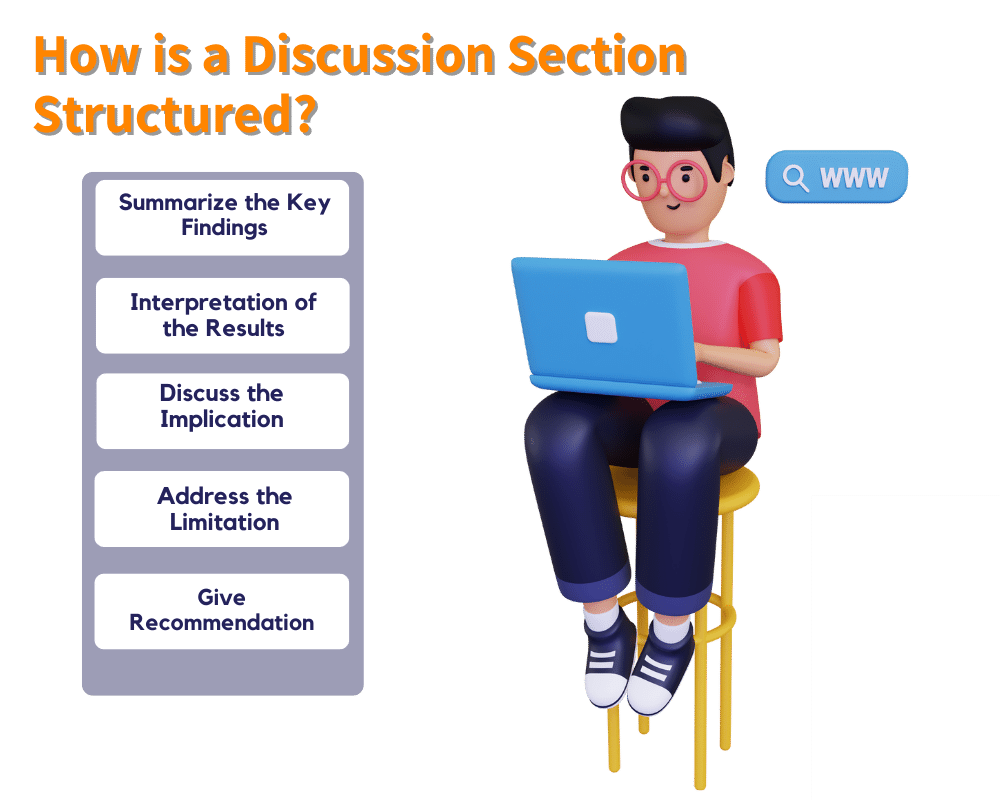
Have you reached the discussion chapter? Are you looking for a bit of guidance? Well, then you are at the right place. In this blog, we will provide tips and directions to compose a clear and easy-to-understand discussion section.
Table of Contents
What is the Discussion Chapter?
The discussion chapter is where you explain and interpret your results within your research paper. The purpose is to discuss the significance and implications of your results.
In this chapter, you will present your research findings in terms of your research questions or hypotheses and relate them to previous studies and literature reviews. You will also have to look at how relevant and significant your findings are to your field of research and argue for the conclusions that you draw from your analysis. This section doesn’t repeat the results section. There are various ways to write this section but there are four key elements that you can focus on:
- Interpretations
- Implications
- Limitation
- Recommendations
How does a Discussion Section Differ from a Conclusion?
A discussion is far more thorough than a conclusion, which only summarizes parts of the study. While discussion evaluates the results rigorously, it requires the researcher to interpret the results by looking at how or why they are the way they are. Furthermore, in the discussion section, the researcher acknowledges limitations and identifies gaps for future research. Finally, based on the research findings and results, it investigates the implication and draws a meaningful conclusion. As a result, whereas a conclusion is brief and only touches on the main points of the study, a discussion is much more detailed.
What to include in the discussion chapter?

As mentioned before, in some studies, the results and discussion chapter are combined, this depends on the type of study you are doing and on the standards set by the university. so, check your requirements given by the university. In this blog, we will treat them as two separate chapters.
The discussion chapter should evaluate the meaning and identify the importance of the data you presented in your findings chapter. Basically, your discussion section gives context to your findings. It should include the following:
- The results of your research
- A discussion of related research
- A comparison between your results and the initial hypothesis.
How is a Discussion Section Structured?

Each discussion second will differ based on the field and the subject of the paper. However, there are basic rules that can be applied to every discussion section to create a framework.
Summarize the Key Findings
Begin this section by restating your research problem and succinctly summarizing your key findings. Instead of repeating all of the data that you previously reported, aim for a statement of the overall result that directly answers your main research question.
Interpretation of the Results
Your results may seem obvious to you but they are not as obvious to the reader. So you need to spell out their significance and show exactly how those results answer your research question.
The structure of your interpretation will differ depending on the type of research, but some general approaches to data interpretation include identifying correlations, patterns, and relationships between data, reviewing your findings within previous research, explaining unexpected results and analyzing their significance, and finally considering possible alternative explanations.
Discuss the Implication
Place the findings in context by ensuring to link your results back to the scholarly work that you surveyed in the literature review. The discussion should demonstrate how your results relate or fit with the existing data on the research, what new insights they contribute and what consequences they pose for the theory or practice.
The aim of this is to show the reader how your research has contributed and why they should pay attention to it.
Address the Limitation
Acknowledge the limitation or weaknesses in your research. This will help build your credibility as a writer because the reader will see that you have critically thought about what your research covers and what it doesn’t.
You may encounter limitations due to the research design, specific methodological choices or unexpected gaps that come up during the research process. Only mention the limitation that is relevant to your research objective and explain the impact they had on achieving the aims of the research.
Give Recommendation
Conclude the discussion section by giving recommendations on a few areas that can be further researched. You can frame your recommendation by linking the need for further research to the limitations of your study. However, don’t go overboard as they can lead to the reader thinking more about the gaps in the research instead of focusing on the actual findings.
What should be avoided in a dissertation section?
A discussion section has possible issues but you can easily navigate them by remaining aware of what not to do.
- Don’t rewrite the findings/results chapter
- Don’t draw a conclusion from the finding without being backed by evidence found in the research’s data or references.
- Don’t bring up new information. The discussion is about examining the information that is already presented in the paper. Adding anything new will only confuse the reader.
- Don’t choose the results to analyse. Don’t only discuss the results that support your research question.
And this is how one should write the discussion chapter of a thesis or dissertation. Also, if you are still confused and looking for further guidance then consider taking our Dissertation Writing Help and we will help you compose a fantastic discussion chapter that will wow everyone.







